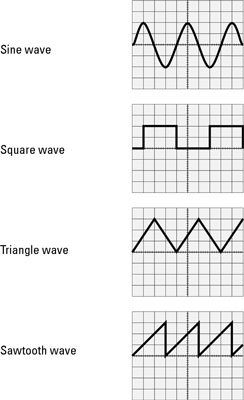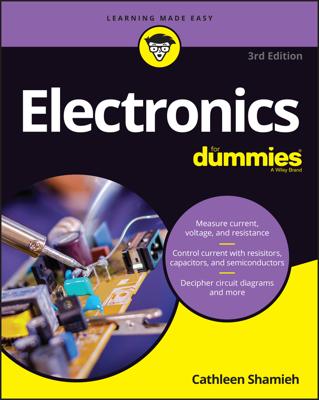There are four basic types of waveforms that you'll run into over and over again as you work with electronic circuits. Waveforms are the characteristic patterns that oscilloscope traces usually take. These patterns indicate how the voltage in the signal changes over time — does it rise and fall slow or fast, is the voltage change steady or irregular, and so on.
They four types of waveforms are:
Sine wave: The voltage increases and decreases in a steady curve. If you remember your trigonometry class from high school, you might remember a trig function called sine, which has to do with angles measured in right triangles.
Few people want to go back to high school trigonometry, so that's all I'm going to say about the mathematics behind sine waves. Suffice it to say, however, that sine waves are found everywhere in nature. For example, sine waves can be found in sound waves, light waves, ocean waves — even the bouncing of a slinky is a sine wave.
And, most importantly from the standpoint of electronics, the alternating current voltage that is provided in the public power grid is in the form of a sine wave. In an alternating current sine wave, voltage increases steadily until a peak voltage is reached. Then, the voltage begins to decrease until it reaches zero. At that point, the voltage becomes negative, which causes the current flow to reverse direction.
Once it's negative, the voltage continues to change until it reaches its peak negative voltage, and then it begins to increase until it reaches zero again. The voltage then becomes positive, the current reverses, and the sine wave cycle repeats.
The number of times a sine wave (or any other wave, for that matter) repeats itself is called its frequency. Frequency is measured in units called hertz, abbreviated Hz. The alternating current available from a standard electrical outlet changes sixty times a second. Thus, the frequency of household AC is 60 Hz.
Most waveforms found in electronic circuits have a much higher frequency than household alternating current, typically in the range of several thousand hertz (kilohertz, or kHz) or millions of hertz (megahertz, or MHz).

Square wave: Represents a signal in which a voltage simply turns on, stays on for awhile, turns off, stays off for awhile, and then repeats. The graph of such a wave shows sharp, right-angle turns, which is why it's called a square wave.
In actual practice, most circuits that attempt to create square waves don't do their job perfectly. As a result, the voltage rarely comes on absolutely instantly, and it rarely shuts off absolutely instantly. Thus, the vertical parts of the square wave aren't actually vertical in the real world.
In addition, sometimes the initial voltage overshoots the target voltage by a little bit, so the initial vertical uptake goes a little too high for a very brief moment, and then settles down to the right voltage.
Square waves are found in many electronic circuits.
Triangle wave: Voltage increases in a straight line until it reaches a peak value, and then it decreases in a straight line. If the voltage reaches zero and then begins to rise again, the triangle wave is a form of direct current. If the voltage crosses zero and goes negative before it begins to rise again, the triangle wave is a form of alternating current.
Sawtooth wave: This one is a hybrid of a triangle wave and a square wave. In most sawtooth waves, the voltage increases in a straight line until it reaches its peak voltage, and then the voltage drops instantly (or as close to instantly as possible) to zero, and immediately repeats.

